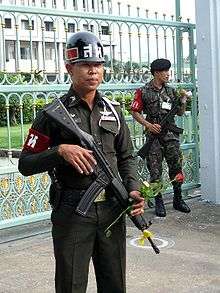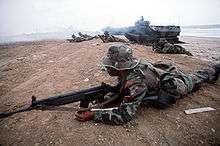Heckler & Koch HK33
The HK33 is a 5.56mm assault rifle developed in the 1960s by West German armament manufacturer Heckler & Koch GmbH (H&K), primarily for export.
| Heckler & Koch HK33 | |
|---|---|
.jpg) | |
| Type | Assault rifle |
| Place of origin | West Germany |
| Service history | |
| In service | 1968–present |
| Used by | See Users |
| Wars |
|
| Production history | |
| Manufacturer | Heckler & Koch, MKEK(licensed) |
| Produced | 1968—2000 (H&K) 1999—present (MKEK)[1] |
| Variants | See Variants |
| Specifications | |
| Mass | HK33A2: 3.65 kg (8.05 lb)[2] HK33A3: 4.0 kg (8.8 lb) HK33KA3: 3.9 kg (8.6 lb) HK53: 3.05 kg (6.7 lb) |
| Length | HK33A2: 920 mm (36.2 in) HK33A3: 940 mm (37.0 in) stock extended / 735 mm (28.9 in) stock collapsed HK33KA3: 865 mm (34.1 in) stock extended / 675 mm (26.6 in) stock collapsed HK53: 755 mm (29.7 in) stock extended / 563 mm (22.2 in) stock collapsed |
| Barrel length | HK33A2: 390 mm (15.4 in) HK33KA3: 332 mm (13.1 in) HK53: 211 mm (8.3 in) |
| Cartridge | 5.56×45mm 5.56×45mm NATO |
| Caliber | 5.56mm |
| Action | Roller-delayed blowback |
| Rate of fire | HK33A2: 750 rounds/min HK53: 700 rounds/min |
| Muzzle velocity | HK33A2: 950 m/s (3,117 ft/s) HK33KA3: 880 m/s (2,887.1 ft/s) HK53: 750 m/s (2,460.6 ft/s) |
| Effective firing range | 200–400 m (219–437 yd) sight adjustments 600 metres (656 yd) with Fero Z24-G telescopic sight |
| Feed system | 25-, 30-, or 40-round detachable box magazine |
| Sights | Rotary rear aperture drum, hooded foresight |
Building on the success of their G3 design, the company developed a family of small arms (all using the G3 operating principle and basic design concept) consisting of four types of firearms: the first type, chambered in 7.62×51mm NATO; the second, using the Soviet 7.62×39mm M43 round; the third, chambered in the intermediate .223 Remington and 5.56×45mm NATO; and the fourth type, chambered for the 9×19mm Parabellum pistol cartridge. Commercially the HK33 was a successful design but it did not sell as well as the G3.
The HK33 series of rifles were adopted by the Brazilian Air Force (Força Aérea Brasileira or FAB), the armed forces of Thailand and Malaysia where they were produced under a licence agreement. The rifle was also licence-built in Turkey by MKEK, and exported from France branded as MAS but actually made in Germany.
Design details
Operating mechanism
The HK33 is a selective fire weapon with Heckler & Koch's roller-delayed blowback system of operation. It employs a two-piece bolt consisting of a bolt head with a pair of rollers and bolt carrier. Upon firing, the two cylindrical rollers in the bolt head are cammed inward by inclined surfaces of the barrel extension and impart a rearward motion on the locking piece, which also propels the bolt carrier rearward. This built-in mechanical disadvantage delays the movement of the bolt head relative to the bolt head carrier which is withdrawing at significant higher velocity of the bolt head. The rollers soon compress entirely into the bolt head, clearing the locking recesses of the barrel extension, and both parts now continue rearward together, opening the breech and actuating the extraction and feeding cycles. The chamber is opened under high pressure, thus the chamber received a series of flutes in order to increase extraction reliability and prevent sticking of the spent casing to the chamber walls.
The G3 roller-delayed blowback mechanism designed around 7.62×51mm NATO ammunition was downsized and revised for reliably using 5.56×45mm NATO ammunition. This required changing geometrical transmission ratio relationships between parts. Based on the geometric relationship arising from the angles of the roller contact surfaces of the locking piece and the barrel extension recesses, the recoil of the bolt head is delayed by a ratio of 3:1 for the 5.56×45mm NATO chambering. Thus during the same period of time, the bolt head carrier moves 3 times faster than the bolt head. This ratio is continued until the locking rollers have been withdrawn from the barrel extension recesses.
Like the G3 bolt the HK33 bolt features an anti-bounce mechanism that prevents the bolt from bouncing off the barrel's breech surface. The "bolt head locking lever" is a spring-loaded claw mounted on the bolt carrier that grabs the bolt head as the bolt carrier group goes into battery. The lever essentially ratchets into place with friction, providing enough resistance to being re-opened that the bolt carrier does not rebound. The spring-powered claw extractor is also contained inside the bolt while the lever ejector is located inside the trigger housing (actuated by the recoiling bolt). Further like the G3 the G33 also contains a spring extractor and a buffer. The ejector lever was installed in the trigger housing and is actuated by the recoiling bolt.
Features
The HK33 is a modular weapon system. Its butt-stock, fore-stock and pistol-grip/fire-control assembly may be changed at will in a variety of configurations (listed below). Simple push-pins hold the components in place and removing them will allow the user to remove and replace parts rapidly. The rifle is disassembled into the following components for maintenance: the receiver/barrel, stock with return spring, bolt assembly and trigger pack in pistol grip.
Trigger
The HK33 has a conventional hammer-type firing mechanism. In the standard version, the rifle comes equipped with an ambidextrous trigger group with a selector lever that is simultaneously the weapon's safety (it has three positions: "S" or "0"—weapon is safe, "E"/"1"—semiautomatic fire, "F"/"25"—continuous fire). The "safe" setting mechanically disables the trigger. The trigger groups can be swapped out to meet the user's specific mission requirements. H&K offers several different trigger assemblies: a three-shot burst fire control group with selector lever/safety (selector settings: "0" weapon is safe, "1" single fire, "2" 2-round burst or "3" 3-round burst; the selector lever is ambidextrous); a "Navy" trigger unit (three settings: safe, semi and full auto fire) and a four-position trigger group (selector settings: safe, single fire, 3-round burst and automatic fire).
Feeding
The rifle is fed from 20- or 25-round steel magazines weighing 250 g or 40-round aluminum magazines (weighing 157 g). 30-round arch magazines were also introduced for use with the rifle. Turkish MKEK-made rifles are issued with 30-round polymer magazines.
Barrel
The barrel contains 6 right-hand grooves and terminates with a slotted flash suppressor that enables the use of rifle grenades and supports a standard G3-type bayonet that mounts above the barrel. The barrel chamber is fluted, which assists in the initial extraction of a spent cartridge casing (since the breech is opened under very high barrel in internal cartridge case pressure). Initially the rifle was produced with a 305 mm (1:12 in) twist rate barrel, which was later upgraded to the faster 178 mm (1:7 in) twist rate (used to stabilize new, heavier NATO-standard SS109/M855 ammunition).
Sights

The firearm is equipped with a relatively low iron sight line that consists of a Drehvisier a rotary rear drum and hooded front post. The rear sight is mechanically adjustable for both windage and elevation with the help of tools. This deliberately prevents non-armorers to (re)zero the iron sight line. The rotary drum features an open V-notch (numbered 1) for rapid target acquisition, close range, low light and impaired visibility use and three apertures (numbered 2, 3 and 4) used for: 200–400 metres (219–437 yd) in 100 metres (109 yd) increments for more precise aiming. The 1 V-notch and 2 or 200 metres (219 yd) aperture settings have an identical point of aim. The V-notch and apertures are calibrated for 5.56×45mm NATO ball ammunition.
The receiver housing has recesses that work with STANAG claw mounts/HK clamp adapters (standard with the HK33, G3, G3SG/1 and MP5) used to mount day (typically the Hensoldt 4×24 telescopic sight) or night aiming optics. The Hensoldt Fero 4×24 telescopic sight and mount assembly were developed for designated marksman use. The Fero elevation knob features Bullet Drop Compensation (BDC) settings for 100–600 metres (109–656 yd) in 100 metres (109 yd) increments calibrated for 5.56×45mm NATO ball ammunition.[3]
Accessories
Included with the rifle are a detachable bipod, bayonet (from the G3), sling, cleaning kit and a magazine loader. Additionally, the HK33 can be used to mount a 40 mm under-barrel HK79 grenade launcher or a blank-firing adaptor.
During its production life the rifle received several minor improvements (these modified weapons are sometimes referred to collectively as the HK33E). The fixed stock was strengthened and the synthetic forearm replaced with a handguard that allows a lightweight bipod to be attached and stowed into two grooves at the base. The shoulder pad in rifles fitted with a telescopic stock was changed to a concave type used thus far in the MP5 series.
Variants

.png)
- HK33A2
- Variant with a rigid synthetic stock.
- HK33SG/1
- An accurized model; equipped with a telescopic sight and improved trigger analogous to the one used in the G3SG/1.
- HK33A3
- Standard rifle but with telescoping metal stock.
- HK33KA3
- Carbine version with barrel reduced in length to the base of the front sight post; also equipped with a folding metal stock. Due to the short barrel, the HK33KA3 cannot be used to launch rifle grenades or mount a bayonet.
- HK53KL
- Compact version of the HK33K. Has a short 211 mm (8.3 in) barrel, a forearm derived from the MP5 submachine gun and a telescopic shoulder stock or receiver endplate cover (later models also received a four-prong flash hider).
- HK13
- Light machine gun. It is fed from either box or drum magazines (the latter has a 100-round capacity), has a quick-change heavy barrel for sustained fire, shrouded with a sheet metal heat guard (replacing the synthetic forearm) and a 2-point bipod adapter.
- Harrington & Richardson T223
- Licensed copy of the HK33 made during the 1960s to compete with the M16 during the smallbore rifle trails. It was mechanically identical to the HK33, except for slight changes to meet the rifle trials requirements. The selector was marked in English (Safe, S.A. (semi-automatic), and F.A. (full automatic)) rather than German (S for Sicher - "secure", or safe; E for Einzelfeuer - "single fire", or semi-automatic; and F for Feuerstoss - "firing burst", or automatic fire). The adjustable bipod was redesigned so that it had a tab that slotted into a mount behind the forend, rather than clamping to the siderails. It used a new straight-walled aluminum 20-round magazine with a bolt hold-open device. The basic T223 kit came with six 20-round magazines, a bipod with carrying case, a bayonet and scabbard, and a webbing-cloth sling. It could also use the Hecker & Koch curved 25- or 40-round magazines, which gave it more capacity than the M16's 20- and 30-round magazines. It wasn't a popular seller, as any qualified client outside the US military who wanted an HK33 could just buy one (and most were still buying G3s and FALs). It was no longer featured in the company catalog after 1967 and all stocks were sold off when H&R went bankrupt in 1986.
- The Navy SEALs trialed it during the Vietnam War with the extended 40-round magazine as standard. Their rifle kit was similar to the commercial box except it came packed with four 40-round magazines instead. Since the magazines wouldn't fit in standard US web gear pouches, SEALs carried them in Chinese-made webgear for AK47 magazines. Although it was popular, the bias against non-American designs, its lack of compatibility with M16 magazines and accessories, and its higher cost than the M16 kept it from being adopted as a standard weapon. Besides, they were still trying to iron out the problems with the Stoner system.
- Type 11
- A derivative of the HK33 manufactured in Thailand by the Ministry of National Defence for use by the Thai armed forces. A bullpup variant also exists with M16 sights and foregrip for close combat in jungle environments.[4]
- MA-11
- A Myanmar-made version of the HK33 assault rifle which was fielded from the late 90s to early 2000s. It was made by KaPaSa in cooperation with Myanmar Fritz Werner Industries alongside engineers from the Electro-Mechanical and Engineering Corps of the Army of Myanmar (EMEC).[5][6] A bayonet can be mounted underneath the barrel.[6] It can use STANAG-adapted magazines.[7]
- MA-12
- A Myanmar-made light machine gun of the HK33 made under license by KaPaSa in cooperation with Myanmar Fritz Werner Industries alongside engineers from the Electro-Mechanical and Engineering Corps of the Army of Myanmar (EMEC), which had a heavy barrel and bipod with a carry handle.[5][6] It can use STANAG-adapted magazines.[7]
Sporting variants

- HK43
- Heckler & Koch also manufactured a semi-automatic only variant of the HK33A2 for the civilian market called the Heckler & Koch HK43. The HK40-series was designed for sale to conscripts so they could be familiar with their service rifle before entering military service, a common practice in Germany and Switzerland. They had a bayonet mount and furniture just like the military model, but came with a semi-auto trigger pack instead of a full auto trigger pack. This allowed a civilian rifle to be easily made into an assault rifle just by dropping in a full auto trigger pack. It would be succeeded by the HK93A2 and its retractable stock version the HK93A3. The HK93 series had a redesigned semi-automatic trigger pack and metal shelf installed in the trigger group well that made it impossible for it to fit a full-auto trigger pack. It also had the bayonet mount removed and had different furniture.
- C-93
- Civilian semi-automatic sporting version produced by Century International Arms, Inc. It comes with an 18.9 or 16.25-inch (413 mm) barrel with a 1:9 twist ratio. A carrying handle and 40-round magazine are standard. Advertised weight is 8.2 lbs. The C-93 is built from Thai Type-11 parts kits using an American made barrel and other miscellaneous American parts.
Combat history
A copy of the Heckler & Koch HK33 was built under licence by Harrington & Richardson as T223 during the Vietnam War. Although heavier than the M16, it was used in small numbers by SEAL teams due to its available 40-round magazine.[8] In Myanmar, the Karen National Liberation Army fielded government-made HK33s.[9] Thai government units fielded HK33s during the South Thailand insurgency.[10] Some of these rifles were seized by groups such as the Patani United Liberation Organisation[11] or the Gerakan Mujahidin Islam Patani.[12] The Kurdistan Workers' Party often claimed it seized HK33s from the Turkish forces.[13]
Users












































See also
- CETME Model L
- FARA-83
- Franchi mod. 641
- Heckler & Koch G41
- INSAS rifle
- SIG SG 530
- List of assault rifles
Notes
- "Archived copy". Archived from the original on 2018-10-25. Retrieved 2019-01-11.CS1 maint: archived copy as title (link)
- Shea, Dan. "HK33 Brochure". Small Arms Review. Small Arms Review. Retrieved 15 July 2019.
- "Fero Z24 4×24 telescopic sight for G3 rifle instruction manual" (PDF). Archived (PDF) from the original on 23 August 2016. Retrieved 25 March 2018.
- "Image of Hock Gun". I257.photobucket.com. Archived from the original on 2013-10-19. Retrieved 2013-10-18.
- "Archived copy". Archived from the original on 2018-05-03. Retrieved 2018-07-25.CS1 maint: archived copy as title (link)
- "Archived copy". Archived from the original on 2018-07-15. Retrieved 2018-07-25.CS1 maint: archived copy as title (link)
- The World's Assault Rifles by Johnson and Nelson, Page 217.
- Dockery, Kevin (December 2004). Weapons of the Navy SEALs. New York City: Berkley Publishing Group. p. 382. ISBN 0-425-19834-0.
- Koorey 2008, p. 165.
- Koorey, Stephanie L.K. (November 2008). Orphans and Icons: Small Arms Control and Armed Groups in Southeast Asia (PhD). Australian National University. p. 176.CS1 maint: ref=harv (link)
- Gunaratna, Rohan; Acharya, Arabinda (2013). The terrorist threat from Thailand : jihad or quest for justice?. Washington, D.C.: Potomac Books. p. 1990. ISBN 9781597975827.
- Lumbaca, Jeremiah C. (June 2005). Islamic Insurgency And Transnational Terrorism In Thailand: Analysis And Recommended Solution Strategy. p. 126. Archived from the original on 2019-03-06. Retrieved 2019-03-06.
- "HPG / PKK : the balance of war for the year 2012". 3 October 2013. Archived from the original on 6 March 2019. Retrieved 6 March 2019.
- Jones, Richard D. Jane's Infantry Weapons 2009/2010. Jane's Information Group; 35 edition (January 27, 2009). ISBN 978-0-7106-2869-5.
- Chile; Marines confirm SCAR 5.56mm rifles order Archived 2013-08-21 at the Wayback Machine - Dmilt.com, 2 August 2013
- "Google Sites". sites.google.com. Archived from the original on 24 November 2016. Retrieved 21 March 2018.
- Montes, Julio A. (May 2000). "Infantry Weapons of the Salvadoran Forces". Small Arms Review. Vol. 3 no. 8. Archived from the original on 2019-01-19. Retrieved 2019-01-19.
- "GIGN in a 2010 exercise". Retrieved 5 April 2019.
- "Archived copy". Archived from the original on 2019-05-21. Retrieved 2019-04-05.CS1 maint: archived copy as title (link)
- "Modern Firearms - HK HK33 and HK53". World.guns.ru. Archived from the original on 2010-09-14. Retrieved 2013-10-18.
- "Kopassus & Kopaska - Specijalne Postrojbe Republike Indonezije" (in Croatian). Hrvatski Vojnik Magazine. Archived from the original on 2010-08-22. Retrieved 2010-06-12.
- "Garda College Yearbook listing weapons training on page 66" (PDF). Archived from the original (PDF) on 2014-01-24.
- "Equipement :: Unité Spéciale de la Police ::". USP.LU. Archived from the original on 2011-07-22. Retrieved 2013-10-18.
- Gander, Terry J.; Hogg, Ian V. Jane's Infantry Weapons 1995/1996. Jane's Information Group; 21 edition (May 1995). ISBN 978-0-7106-1241-0.
- Alpers, Philip (2010). Karp, Aaron (ed.). The Politics of Destroying Surplus Small Arms: Inconspicuous Disarmament. Abingdon-on-Thames: Routledge Books. pp. 168–169. ISBN 978-0-415-49461-8.
- Montes, Julio A. (August 2011). "Peruvian Small Arms: Gunning for the Shining Path" (PDF). Small Arms Defense Journal: 25–29. Archived (PDF) from the original on 2016-03-04. Retrieved 2018-07-05.
- "Rice Not Guns - German Arms in the Philippines". Archived from the original on 7 September 2010. Retrieved 23 December 2014.
- |url-status=live}}
- Archived December 13, 2008, at the Wayback Machine
- "Archived copy". Archived from the original on 2018-09-23. Retrieved 2018-09-22.CS1 maint: archived copy as title (link)
- "Google Sites". sites.google.com. Archived from the original on 24 November 2016. Retrieved 21 March 2018.
- Robert Muggah and Emile LeBrun, ed. (October 2010). Timor-Leste Armed Violence Assessment Final Report (PDF). Special Report No. 12. Small Arms Survey. p. 17. ISBN 978-2-940415-43-4. Archived (PDF) from the original on 2017-05-05. Retrieved 2018-08-30.
- "MKEK - Makina ve Kimya Endüstrisi Kurumu". Archived from the original on 7 May 2016. Retrieved 23 December 2014.
- SAS Weapons - HK33 / HK53
- "Guns of the United States Border Patrol". Human Events. Archived from the original on 2010-05-07. Retrieved 2013-10-18.
References
- Johnson, Gary Paul; Nelson, Thomas B. (2016). The World's Assault Rifles. Ironside International Publishers. ISBN 978-1-61984-601-2.
- Woźniak, Ryszard (2001). "p. 105-107". Encyklopedia najnowszej broni palnej - tom 2 G-Ł (in Polish). Warsaw, Poland: Bellona. ISBN 83-11-09310-5.
External links
| Wikimedia Commons has media related to HK33. |